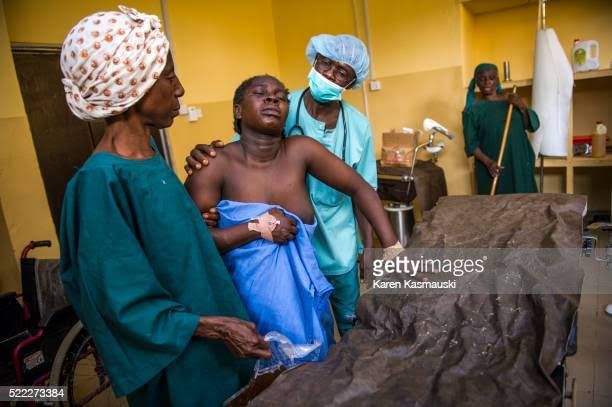
The reality of female genital mutilation FGM
It was about 5:00am when Adaku started screeimng, her husband Udoka took her to Nwayiocha a well known traditional birth attendant (TBA) in Umuome community, she has delivered a lot of babies in her community and other neighbouring communities.
Adaku is about having a baby for the first time after their wedlock, being her first experience the labour pain was so severe that she could not control herself but cry and shout on their arrival to Nwayiocha's place she took her into her small hut which serves as her delivering room for examination.
"Her cervix is yet to dilate" said Nwayiocha, but let me keep examining her if in the next four to six hours she does not deliver you Will move her to the primary healthcare center in the next village. By 12noon she was still going through excruciating labour pain and the cervix yet to dilate so, the traditional birth attendant Nwayiocha advised them to take her to the hospital because she has done all she could do.
Udoka was restless, he did not Know what to do so he called a taxi driver and he negotiated with him to take them to the next village where the primary healthcare center is located, on arrival the nurses took her to the labour room for another examination they asked Mr Udoka how long she been in this labour, he said since morning about 5: 00am, where were you all through this period? He said we went to a nearby traditional birth attendant when she could not deliver her of the baby she asked us to bring her down to this place .Mr Udoka am afraid we can not deliver her of this baby here, you would have to take her to the teaching hospital in town because we don't have the facilities to carry out a cistercian session (CS). "Oh God! Don't let my wife die I don't have enough money to go through this process now, nurse you can do something please". please take her to that place before you loose her the nurse said.
Udoka was devastated.
Adaku was taken to the teaching hospital in the town, she was kept in the intensive care unit (ICU) while the gynaecologists and other medical team thought of the measure to take in order to save her life at least. From the (ICU) she was taken to the surgerical theatre for a Cistercian session (CS) within two hours she was delivered of the baby but remained unconscious for some time.
In the process of the examination by the gynaecologists it was discovered that her birth canal was not wide enough for the foetus to pass through because her genetal organ was multilated when she was about eight days old according to their cultural belief, to further prove the doctor's report Mr Udoka her husband testified that from the first sexual intercourse they had, she often feel pain in her vegina during sex and as such he finds it difficult to penetrate at such they don't enjoy sex.
Fact about Female genital mutilation (FGM) around the world.
Medically reviewed by University of Illinois — Written by Alex Novakovic on May 15, 2017
Types
Complications
Prevalence
Why does FGM occur?
Human rights
Female genital mutilation refers to the partial or complete removal of the external female genitalia. It is typically done between infancy and the age of 15, but adult women may also undergo the procedure.
The term female genital mutilation (FGM) includes any injury to a woman or girl’s genitalia for reasons other than medical ones, commonly religious. The practice is thought to have started before the advent of either Christianity or Islam.
FGM is sometimes called female circumcision, but the implications of female circumcision are quite different from those of male circumcision. Nowadays, more FGM operations are carried out by healthcare professionals, including up to 77 percent of cases in Egypt.
However, 4 in 5 operations worldwide are still performed by a traditional practitioner, often in unsanitary conditions, with serious health implications.

FGM is most common in the north-eastern, western, and eastern regions of Africa, and some parts of the Middle East and Asia. More than 200 million girls and women alive today are estimated to have experienced FGM in the 30 countries where it is most common.
facts on female genital mutilation:
The practice is carried out for social, religious, and cultural reasons.
There are varying types of FGM, ranging in severity.
It is considered a human rights issue.
Types
The World Health Organization (WHO) describes four main types of female genital mutilation:
Type 1: Clitoridectomy
The practice mostly affects women in East and North African countries.
In this practice, the clitoris is partially or completely removed.
The clitoris is the most sensitive erogenous zone of a woman and the main cause of her sexual pleasure.
It is a small erectile part of the female genitalia. Upon being stimulated, the clitoris produces sexual excitement, clitoral erection, and orgasm.
Type 2 Excision:
The clitoris and labia minora are partially or completely removed. It may also include the removal of the labia majora. The labia are the lips that surround the vagina.
Type 3: Infibulation
The vaginal opening is narrowed, and a covering seal is created. The inner or outer labia are cut and repositioned. This practice may or may not include the removal of the clitoris. Other procedures include cauterizing, scraping, incising, pricking, or piercing the genital area, for reasons other than medical purposes.
Type 4
The WHOTrusted Source describes this type as “all other harmful procedures to the female genitalia for non-medical purposes” and includes practices including pricking, piercing, incising, scraping, and cauterizing the genital area.
Complications
Removing normal, healthy genital tissue does not provide any health benefits, and undermines a woman’s natural functions. It can also lead to complications. The exact number of fatalities due to FGM is not known, but in parts of Somalia where there are no antibiotics, it has been suggested that 1 in 3 girls who undergo the operation die because of the practice.
Complications that can occur during or soon after FGM procedures include:
bleeding
bacterial infection
open sores in the genital area
urine retention and other urinary problems
damage to nearby genital tissue
severe pain, possibly leading to a loss of consciousness
Common long-term complications include:
recurrent bladder infections
cysts
infertility
increased risk of newborn deaths
higher rate of childbirth complications
There may also be a need for further surgery.
If the opening has been narrowed, it will need to be reopened before marriage to enable sexual intercourse and childbirth. In some cultures, this opening and narrowing is done several times throughout a female’s life.
Prevalence:How common is it?
In some places, FGM is a relatively new practice that communities have adopted from neighboring communities. In some cases, it is the revival of an old custom.
Immigrants to places where FGM is not practiced may take the custom with them, and people who move into a location where it is practiced may adopt it.
According to the WHO and UNICEF:
Over 200 millionTrusted Source females have experienced some form of FGM.
The percentage of females aged 14-49 yearsTrusted Source who had undergone FGM in 2013 ranged from 98 percent in Somalia to less than 1 percent in Uganda.
Younger women are less likely to undergo FGM
In Africa alone, it is believed that approximately 92 million girls aged 10 years and over have undergone FGM procedures. Approximately 3 millionTrusted Source girls in Africa are thought to undergo FGM each year. In eight countries, the prevalence is 80 percentTrusted Source.
Why does it occur?
There is no medical reason for FGM. The practice occurs for a combination of reasons, based on cultural, social, and religious practices.
Social reasons for why FGM occurs
In societies with low literacy rates, social convention says, “it is what others do, and what we have always done.” Social pressure and a desire not to stand out as a rebel are a powerful force. In some communities, women who have not undergone FGM are not allowed to handle food and water because they are unclean, and seen as posing a health risk to others.
For these societies, it is the “proper” thing to do as a part of the female upbringing. It is said to prepare a girl for marriage and adult life. In some cultures, people believe that an uncut clitoris will grow to the size of a penis, or that FGM makes a woman more fertile.
Cultural reasons for why FGM occurs
To some, FGM represents decent sexual behavior. FGM is often linked to virginity and being faithful during marriage. The damage to the genitalia means the chance of a woman having illicit sexual relations is reduced – because her libido is decreased, and the opening is too narrow.
Femininity and modesty can be a factor. In some societies, a woman is perceived to be cleaner and more beautiful if her genitals are cut. Some body parts, such as the clitoris, which protrudes, are seen as male and unclean.
Religious reasons for why FGM occurs
None of the major religions prescribes female circumcision. People in some communities, especially where there are low levels of literacy, may have heard that the practice is a religious one. Over time, religions have tolerated, encouraged, and condoned the practice; but, today, many religious leaders are against FGM and are involved in the movement to eradicate its practice.
If the people with power and authority in a place believe and agree that FGM should prevail, it is difficult to prevent it. People who may insist on its continuing include local chiefs, religious leaders, practitioners of FGM and circumcision, and some healthcare professionals.
FGM: A human rights issue:
The practice has been widely condemned and campaigns including the ‘International Day of Zero Tolerance to Female Genital Mutilation’ have been supported by the U.N. and Unicef.
Most countries in the world consider FGM a violation of a woman’s human rights and an extreme form of discrimination against females in the community.
As most procedures are carried out on young girls, it is also a violation of children’s rights. The WHOTrusted Source write:
“Female genital mutilation also violates a person’s rights to health, security and physical integrity, the right to be free from torture and cruel, inhuman or degrading treatment, and the right to life when the procedure results in death.”
In 2008, the World Health Assembly passed a resolution on the elimination of FGM, calling for action by all those involved in justice, women’s affairs, education, finance, and health.
Worldwide banning of FGM
In 2012, the United Nations adopted a resolution banning FGM worldwide, stating that “All necessary measures, including enacting and enforcing legislation to prohibit FGM and to protect women and girls from this form of violence, and to end impunity.”
While the intervention is somewhat safer when carried out by a doctor, the WHO urges health professionals not to perform FGM.
They suggest accepting minimal procedures that do not entail long-term health risks. They say that this approach is “culturally sensitive, does not discriminate on the basis of gender, and does not violate human rights.” However, surveys show that, in countries where FGM is common, most women aged 15-49 think FGM should end.